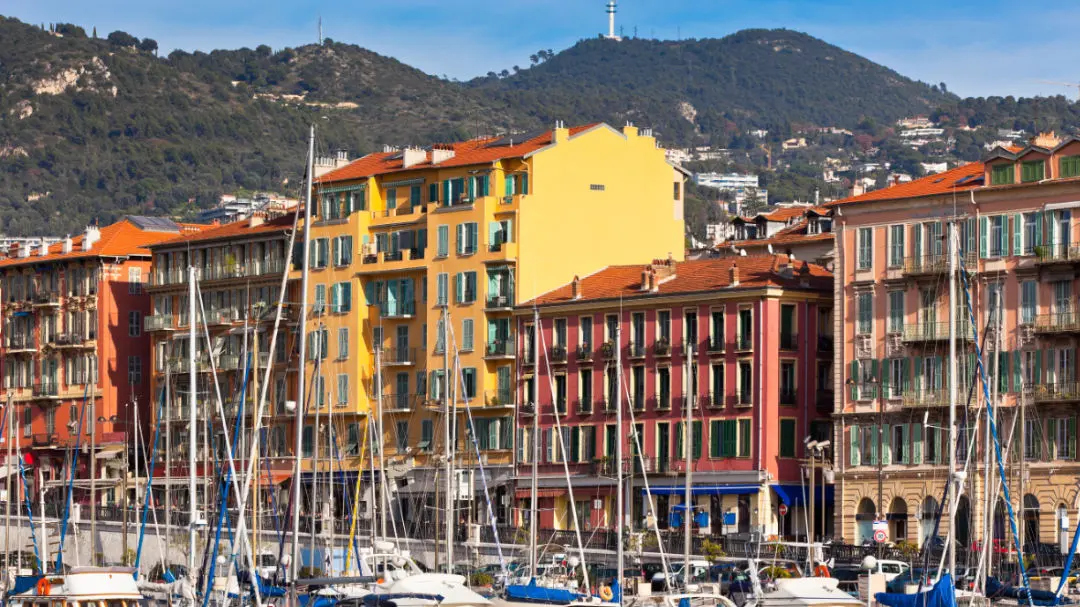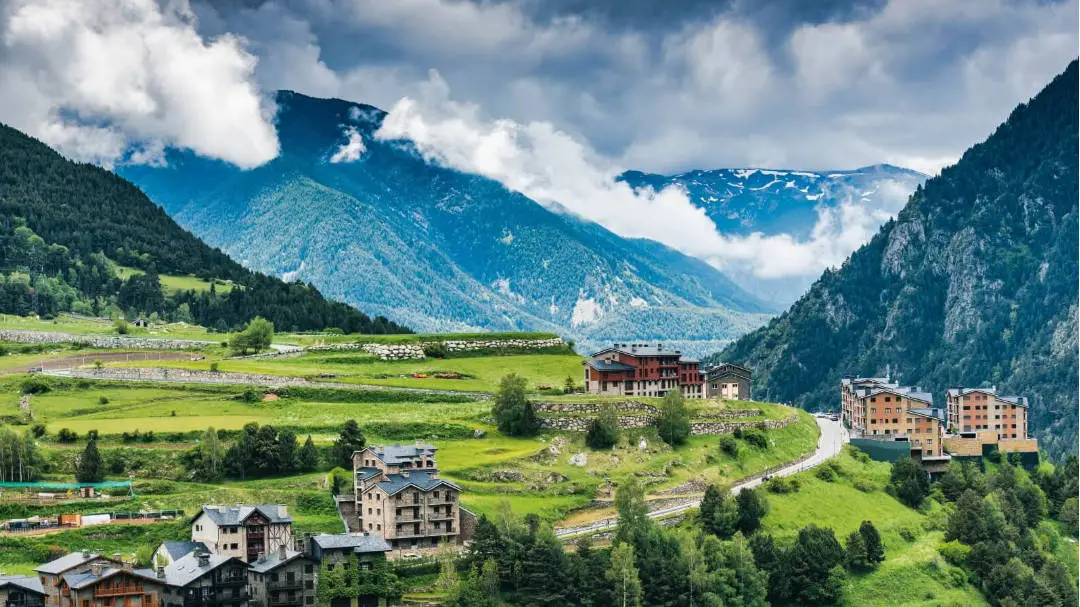Van Travel
The South of France is some of the best weather, amazing scenery and delicious food in all of Europe and to experience all of this from the comfort of your home on wheels, certainly makes it an amazing place to visit. It is a popular destination with variety. Offering a range of scenic roads, beautiful coastal towns, and iconic cities such as Marseille and Nice. With this complete guide, planning ahead and familiarizing yourself, you will be able to make the most of your enjoyable and safe motorhome or campervan trip to the South of France.
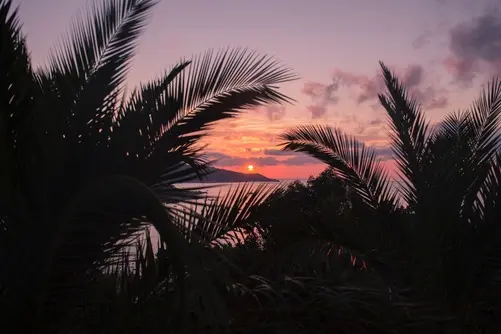
Enjoy palm trees and sunsets for days
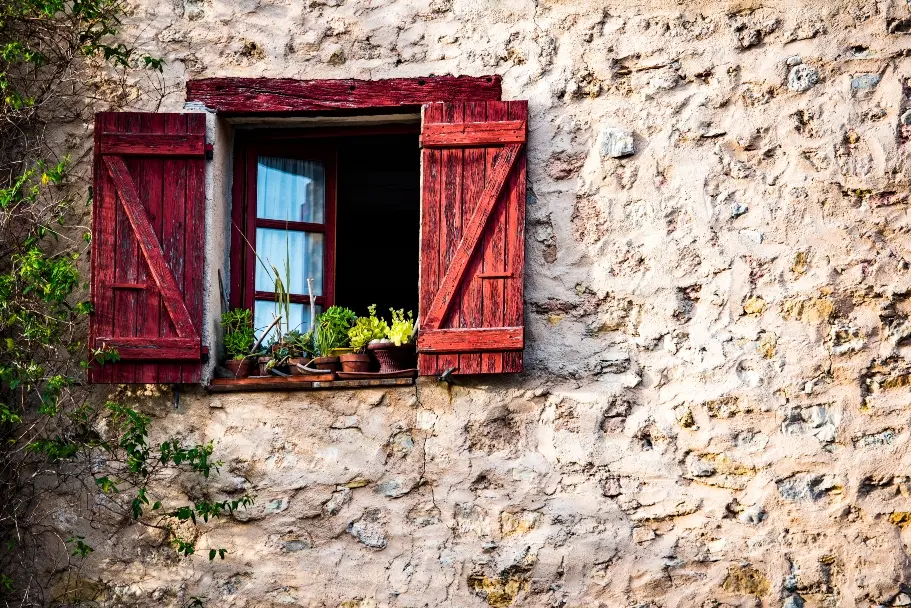
Quaint south of France houses

Table of Contents
South of France
The French Riviera, also known as the Côte d’Azur, is a beautiful coastal region located in the south of France. It’s known for its stunning beaches, clear blue waters, and Mediterranean climate. Some famous and popular tourist destinations on the French Riviera include Cannes, Nice, Monaco, and Saint-Tropez. These cities offer a range of cultural attractions, including museums, art galleries, and historic sites, as well as shopping, cultural hubs, dining, and nightlife options. The French Riviera stretches for five hundred and fifty miles of what feels like endless sun, sea, and beautiful beaches. The stunning coastlines, inviting Mediterranean seas, rugged mountains of the Alpes Maritimes, and incredible cosmopolitan cities make it a haven for road trips and an excellent destination for beach lovers to adventure enthusiasts.
People and culture
The people and culture of the south of France are as diverse and captivating as the region itself. From bustling cities to quaint villages, the locals are known for their warmth and hospitality. They take pride in their rich history and cultural heritage, and it shows in their love for food, wine, and the arts. The region is known for its delicious cuisine, including fresh seafood, cheese, and local produce. Wine lovers will be in heaven, as the South of France is home to some of the world’s most famous vineyards, producing some of the finest wines. The people here also have a strong connection to the arts, with many famous painters, writers, and musicians have called this place home. Whether you’re exploring the markets, sipping on a glass of wine, or admiring the street art, the people and culture of the South of France will leave you feeling inspired and rejuvenated. If you learn a few of the basics of the french language you will be greeted by warmth and friendliness.
Best time of year to visit
In a motorhome and Campervan; we highly recommend visiting the South of France during Spring/Early Summer or Autumn. We recommend absolutely recommend avoiding the summer holidays and peak summer. France is one of the most visited countries in the world, with up to 100 million visitors a year, and a significant number of those are travelling with their families in the Summer time- June, July and August. Although you will be fine to visit during those times the impact it does have is the accessibilities of AIRES, parking spots, congestion and traffic on the roads and how busy it gets sightseeing. Late April to the end of May are fantastic times to visit as the weather is starting to get warm, and it’s not so crowded. This goes for September and October too. As well as being quieter, the weather is pleasant and places are calmer, more relaxed, and you are more likely to avoid any extreme heat. Winter can also be a fantastic time to visit and historically used to be the time most tourists would visit the french riviera. Temperatures are still warm, mild and lovely, there is sunshine and a relaxed beach vibe but you may get more spells of rain and chilly evenings.
Explore your surroundings
Things to see
- Marseille
A vibrant port city with a rich history, great food, and a lively atmosphere. - Gorbio
Medieval hilltop town, with stunning views and history. - Saint-Tropez
A picturesque fishing village is known for its upscale atmosphere and sandy beaches. - Saint-Maxime
A beautiful beach town, around the bay from Sainte-Tropez that has an amazing market and boho vibes. - Menton
Next to the Italian Border, picturesque, coloured buildings and incredible beachs. - Nice
UNESCO city steeped in amazing architecture, beachfront living and markets - Aix-en-Provence
A beautiful city known for its thermal springs and stunning architecture. - The French Riviera Roadtrip
Toulon to Menton coastal road, through vibrant cities and unbelievable beaches. - Verdon Gorge
Beautiful deep green canyon, with clear water and adventure sports. - Cassis
A tiny and bustling port town, with incredible views of the marina and hilltop ruins, parking can be tough though. - Cannes
A stylish city is known for its famous film festival and chic boutiques. - Antibes
An old town, with laneways, palm-tree lined streets, a fabulous market, bohemian stalls and a fantastic beach.
Local Cuisine
The cuisine of the south of France, also known as “Provençal” cuisine, is known for its use of fresh, local ingredients and its focus on simple, yet flavorful dishes. The region’s Mediterranean climate allows for an abundance of fresh produce and in particular herbs. Seafood is also a staple of Provençal cuisines, with bouillabaisse, a traditional fish stew, and grilled sardines being popular choices. Provençal cuisine is also very popular for its local abundant Vegetable produce and dishes like Ratatouille. The region is also known for its olive groves and olive oil production; Tapenade as well as their excellent wine, which is used in many dishes and as a condiment. In addition to its savoury dishes, the south of France is also famous for its sweet treats, such as the classic dessert tarte tropézienne, which is a creamy custard-filled brioche, and calissons, an almond-based candy.Overall, the cuisine of the south of France is characterized by its use of fresh ingredients, simple preparation methods, and bold flavours. It’s a cuisine that celebrates the natural bounty of the region and the Mediterranean way of life.
Marseille
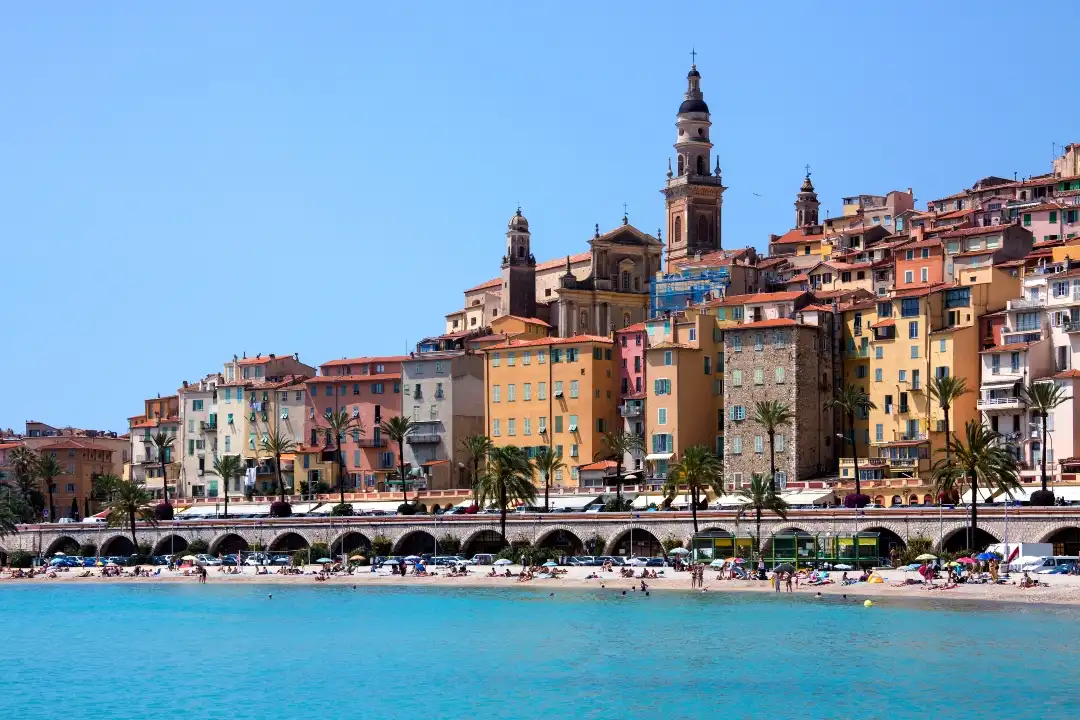
Marvellous Menton
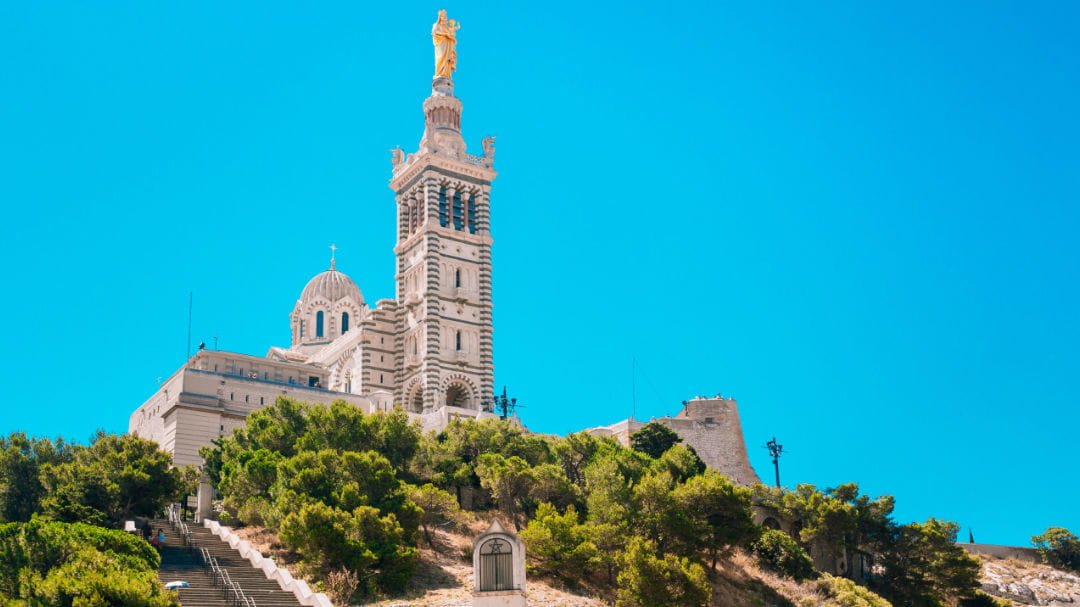
Basillica of our lady, Marseille
Getting there
You can either take your campervan or motorhome by the channel Tunnel to France or by Ferry. The tunnel is faster and more convenient but a little bit more expensive.
If you are travelling with pets they are allowed on both ferry and Chunnel.
Ferries
Channel Tunnel/Chunnel
If you prefer a non-ferry option to France, you can take the channel tunnel or chunnel as it is affectionately called. So, you won’t actually be driving through the tunnel yourself, but you will drive onto a tunnel shuffle train, you park and then it does all the magic for you. It is like being on a train with your vehicle. You can sit in your vehicle for the duration of the crossing, which takes around 35 minutes from Folkestone to Calais. The channel tunnel train, which is called Le Shuffle is operated by Euro Tunnel. Expect to pay at least £150 per vehicle (vans up to 8 metres) one way, if you book in advance, it is usually cheaper.
Borders
Crossing the French border can be a straightforward process, depending on your country of origin and the reason for your visit. If you are a citizen of the European Union (EU), you are able to cross the border freely without the need for a visa or passport. However, if you are a non-EU citizen, you may be required to have a visa and a valid passport to enter France. It is always recommended to check the entry requirements for your specific country before traveling. When crossing the border, you may be subject to passport control, customs checks, and security screenings. Be prepared to show your travel documents and declare any items that are subject to duties or restrictions. Remember to be patient, cooperative, and respectful of the border control officers, as their primary goal is to ensure the safety and security of the country
Crit’air
The important thing to remember is you have to buy them before travelling to France as they take about 10 days to receive. Unfortunately, you cannot buy them in France on the spot if you need one, which is quite annoying.Buy them here
Currently, these are the 11 Restricted Traffic Zones/ ZCRs:
- Paris
- Greater Paris
- Lyon
- Grenoble-Alpes-Métropole
- Aix-Marseille-Provence
- Nice-Côte d’Azur
- Toulon-Provence-Mediterranean
- Toulouse
- Montpellier
- Strasbourg
- Rouen-Normandy
Roads and Navigation
Road rules
Drive: Left-hand drive
Speed limits:
30mph/50 kph on main roads and built-up areas
50mph/80kph main roads outside built-up areas (A/B roads)
70mph/110kph Dual carriageways.
80mph/130kph Motorways
Tollways & vignettes:
As mentioned- Crit’Air

Enjoy a walk through the lavender of Provence
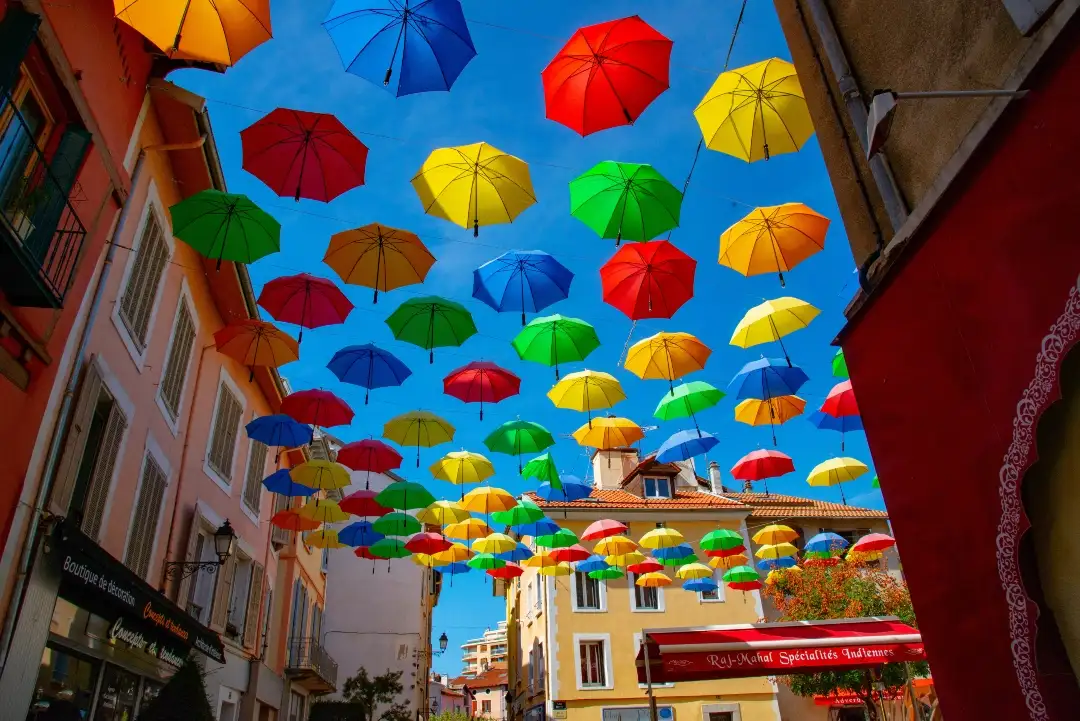
Nice to be in Nice
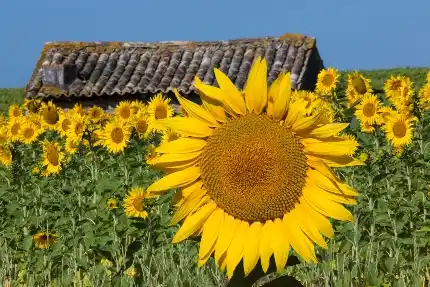
Sunflowers in the sun
Routes and roadtrip itineraries
Regions
The route of the French Riviera runs all along the southeast coast of France. Traditional it is considered to extend from Toulon (after Marseille) to Menton on the Italian Border. You can elongate this route and go all the way along the coast starting in the Languedoc-Roussillon region, All the way from the Spanish Border to the Italian border. We did this route and believe the most unmissable and beautiful coasts are located along the stretch from Cassis to Menton.
Roadtrips:
- Visiting the perfumeries in Grasse to the picturesque lavender fields of Provence.
- Adventure along Verdun gorge to Lac de Saint-Cassien
- Explore the beaches along the coastal road.
- Enjoy a road trip through the rugged mountains of the Alpes Martimes.
Motorhome and campervan hire France
There are several companies that offer motorhome and campervan rental services in France, all at different price points, sizes and vehicles for your needs. some reputable companies include:
Make your bookings early for summer and peak seasons.
France environmental code
The outdoor country code in France is referred to as the “Code de l’ environnement” (Environmental Code). This code establishes the legal framework for environmental protection in France, including regulations for outdoor activities, nature conservation, and waste management. It also establishes the rights and duties of citizens and organizations in relation to the environment. The code is constantly updated to reflect new environmental challenges and is an important tool for the protection of France’s natural resources. France has several national parks, which are protected areas dedicated to conserving the country’s natural heritage. Some of the most popular national parks in France include:
- Vanoise National Park
Located in the French Alps, this park is home to a diverse range of wildlife and is a popular destination for hiking, skiing, and mountain climbing - Mercantour National Park
In the southeastern region of France, this park is known for its rugged mountain landscapes, alpine meadows, and crystal-clear streams. - Calanques National Park
Located near Marseille, this park is home to a unique landscape of rocky cliffs, clear waters, and Mediterranean vegetation. - Port-Cros National Park
On an island in the Mediterranean, this park is known for its unspoiled beaches and clear waters, making it a popular destination for diving and snorkelling. - Ecrins National Park
Located in the southeastern region of France, this park is known for its high mountain peaks, glaciers, and alpine meadows, making it a popular destination for outdoor activities such as hiking, climbing, and skiing.
Overnight parking is usually prohibited in these national parks, always double-check and do your own research before staying the night.
“Wild camping” in the south of France
“Wild camping” or free overnight parking in non-designated areas are often allowed however it is recommended that Aires are used instead. Laws towards parking in France are much more relaxed than in the UK. In French law, you are allowed to park your campervan and motorhome in a layby or by the side of the road. As a general rule, parking restrictions and overnight parking are not permitted along the coast, in national parks, protected natural sites, or near historic monuments. Which is entirely understandable. Local authorities can set up their own rules and regulations, so always read the road signs before parking. Parking is available at most tourist destinations, and there are lots of rest stops along motorways to spot. No matter how rural you are, you will always be able to find an AIRE. We recommend always trying to park overnight in an AIRE, or somewhere with no parking restrictions. Do your own research when you get to an area and make sure you read and obey the signs in the area. Although wild camping is permitted in France you must get permission from the landowner if it looks like private property.
We found Park4night to be an excellent resource as always, and found wild park ups as well as lots of aires, free and paid for.Check out our go to rules for Wild Parking! Camperstop is another valuable app to have whilst travelling around France! It has thousands of unique motorhome and campervan stops and campsites to stay in. It costs only € 5.99 per year of which you have access to over 12,000 places all over Europe.
Aires
In our opinion, France is the best place in Europe for motorhome and campervan services. They have an extensive network of Aires. Aires are rest areas for motorhomes, RVs and campervans. They are located all around France, typically in every municipal and near tourist attractions. Aires are safe places you can park overnight, with full facilities: wastewater disposal, fresh potable water filling and electricity hook-up. In the south of France, there are many aires to choose from, depending on your destination and travel itinerary. Some of the most popular aires in the south of France are:
- Aire de Service de la Camargue in Saintes-Maries-de-la-Mer
- Aire de Service des Alpilles in Saint-Rémy-de-Provence
- Aire de Service des Gorges du Verdon in Castellane
- Aire de Service de la Côte d’Azur in Nice
- Aire Sainte Maxime
It is important to note that even though there are lots of Aires, there are not as many Aires in the south of France region compared to other regions of France, so do your own research beforehand and maybe pre-plan your route, so you always have services. Another reason to plan ahead is some aires may have a fee for overnight parking and may have limited availability during peak tourist season. So if you are travelling in the peak of summer, arrive early, as spots fill up very quickly!
France passion
“France Passion” is an absolutely excellent concept. It is a guide for campervans’ & motorhomes on unique places to stay that welcome motorhomes and campervans. For only €30, you have access to over 17,000 free parking spots at vineyards, farms, and homestays. The guide is updated and runs yearly from March until the following Easter and is available to purchase here.
Campsites
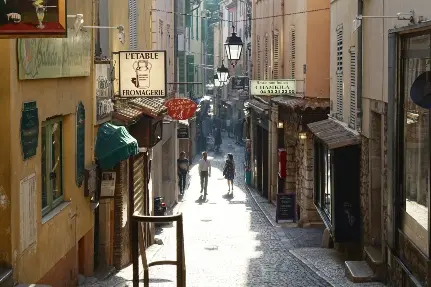
Antibes is not to be missed
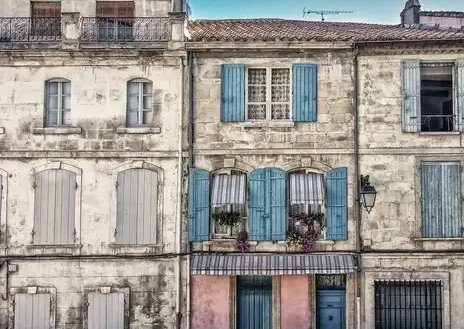
Rustic houses with shutters
Shopping, supplies and amenities
France has one of the strongest economies in Europe. They use the Euro and you can expect to pay slightly cheaper but similar pricing for goods, services and groceries to the UK. Seasonal and local produce is usually where you will find your savings; like wines, cheeses, and cognacs. (win) You will find a bakery on every street corner (even in the remotest corners of France) meaning you are never too far from amazing bread and pastries. You won’t have a problem finding ATMs and paying with cards is widely accepted.
The major retailers are:
- Lidl
- E. Leclerc
- Aldi
- Auchan
- Carrefour
It is very common for shops to close on Sundays and Public holidays. Operating hours in the day usually go from 10- 6pm-8pm and often in smaller shops there is a 1-2 hour break for lunch. Top tip do your groceries before Sundays.
Cost of living
Some areas of the south of France, such as the French Riviera, can be quite expensive, while other areas in the region are more affordable. If you are doing vanlife in the region, then your costs are always going to be cheaper as you can cook yourself and avoid accommodation costs. whilst parking sometimes isn’t free you can find decently priced aires and campsites.
Eating at local markets or boulangeries can be a cost-effective way to sample the local cuisine and shopping locally at markets is another way to keep costs down.
Average prices
- Coffee £2.57
- Milk £0.92 per litre
- Loaf of bread £1.38
- Potato (1kg) £1.56
- Meal for 2- mid-range restaurant £53.00
- Domestic Beer 1/2 litre £1.83
Motorhome, campervan and camping stores
France is home to possibly one of the most well-stocked and best outdoor brands: Decathlon. You are in good hands if you need outdoor supplies in France. There are 338 Decathlon stores in France, dotted all around every region, check out map here.
Campervan and Motorhome supplies are easy to find. If you run into any troubles with your van you’ll be able to get what you need and back on the road fairly easily. You will be able to find a motorhome repair or supply shop in every major city. Check out this list here which will help locate motorhome supplies in France
Public toilets
Your best bets for public facilities and toilets are roadside service stations, petrol stations and in towns: usually in shopping malls, fast food joints like Macdonald’s restaurants, and sometimes in town centres, or at tourist sights.
These are toilet locator apps that could be helpful:
Free water taps
Filling up on water couldn’t be easier. Most AIRES provide a water tap, and even if you are not staying the night or parking during the day you can usually pay for services or services are free! As well as aires there are Eurorelais terminal services stations all over. These Eurorelaise stations have a black & grey water disposal, potable water tap and electricity point. Usually, for the price of a few euros, you will be able to fill up your tank. If you are going on a trip into towns and urban centres check out locations of public water fountains and taps. Use this free tap locator map. To help you find them
Grey and black waste disposal
Grey and black water disposal areas and units are found all over the South of France and France, either at eurorelais stations, Aires or campsites. They are all heavily signed posted from main roads and motorways.
Lpg pumps
Liquid petroleum gas may be your fuel source for heating and cooking while you are on the road. LPG isn’t available from all petrol stations and pumps in France, but you can find an extensive map of LPG stations here.
Petrol stations
Petrol stations are everywhere, you won’t have trouble filling up. The major petrol stations are
- BP
- ENI
- ESSO
- CARREFOUR
Find the current price of petrol here to help plan your trip and budget.
Cellular networks and wifi
The French riviera has a well-developed telecommunications infrastructure, including both Wi-Fi and cellular networks. We found Orange to be a great option, as it is the largest network in France so provides excellent coverage at a reasonable price. We travel with a netgear nighthawk M1 wifi router and it works an absolute treat.
Essential safety
- Ambulance: 15.
- Police: 17.
- Fire: 18.
- General Emergency: 112
(EU-wide emergency number that will contact emergency services in any EU country or language; have this number on hand while travelling around Europe!)
If you are travelling from the EU or UK you can get a free reciprocal Medical card which allows you to get free emergency treatment in France, which can be used for the duration of your trip. You can sign up for the GHIC OR EHIC Card (that’s what it is called) here. It is strongly advised that if you are travelling from outside the EU zone then you should invest in good quality health/holiday insurance coverage.
Staying Safe in your vehicle
Areas with high tourism like Paris or Marseille are rife with criminals that target motorhome tourists. For that reason, petty theft and break-ins happen all the time. We got our van broken into along the French Riviera in a place called La Ciotat. When speaking to other motorhomes in the area we found that a number of people had the same break-ins happen to them there. so I would absolutely advise on AVOIDING this area of the coast. We left the van for 5 minutes to look at a viewpoint and came back to a smashed side window. Luckily we travel with a guard dog so they never made it into our van but having to get a new window was a pain to organise.
The following tips will help you to prepare your and your van’s safety.
- Have a very solid security set-up before travelling: a safe or somewhere you can store valuables, and never leave them in your vehicle.
- Try to avoid leaving your van unattended.
- If you have to leave your van unattended use guarded parking, a campsite, well-lit parking lots, secure parking facilities and parking areas that are busy with no blind spots.
- Before leaving your vehicle take photos of your van and know exactly where it is either using coordinates or What.3.words app.
- Have cash and or some credit cards kept in a safe place in case you do get robbed you have emergency means.
- If something doesn’t feel right, trust your intuition and leave.
- Be on the lookout and report suspicious behaviour.
- Report crime to the police on 17 or 112.
Travelling with pets in the South of France
A very pet-friendly place, France is incredibly easy to travel in and around with your pets. Getting to France with pets is convenient. Almost all ferry operators to France are pet friendly; either pets can stay on board in a kennel or stay in your vehicle for the duration of travel. Some ferries even allow pets to travel for free. The Eurotunnel also accepts pets, which will be allowed. to stay in your vehicle with you, and costs only £22 per pet. Make sure you read the government requirements for pet travel to France with pets and what they will need before you travel. Here is a list of the legal requirements for travelling to France with pets.
- Up-to-date vaccinations, worming and flea treatments
- Up-to-date Rabies vaccine (given at least 3 weeks before travel)
- Microchipped
- Animal Health Certificate (arrival into France within 10 days of Travel). or EU issued Pet passport.
Since Brexit, The UK is no longer part of the European Union meaning they no longer benefit from the privilege of pet travel with European pet passports. Brits travelling in France and Europe will now need a valid animal health certificate instead. animal health certificate last for four months and cost between £90-£150 per pet. You must travel within ten days of the issue of the animal health certificate. It is also possible to travel with an EU country-issued pet passport if accepted by the authorities. Read more about that on our European pet travel blog here.
We hope you enjoyed reading as much as we enjoyed writing. If you are heading to France soon we hope you have a bon voyage. Please feel free to sign up or leave a comment below if you enjoyed the read!
